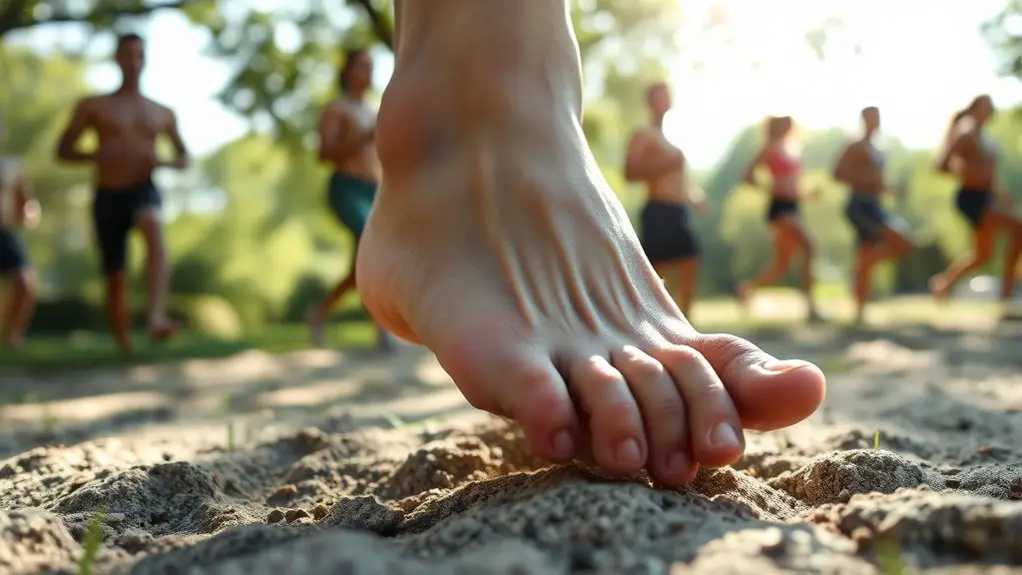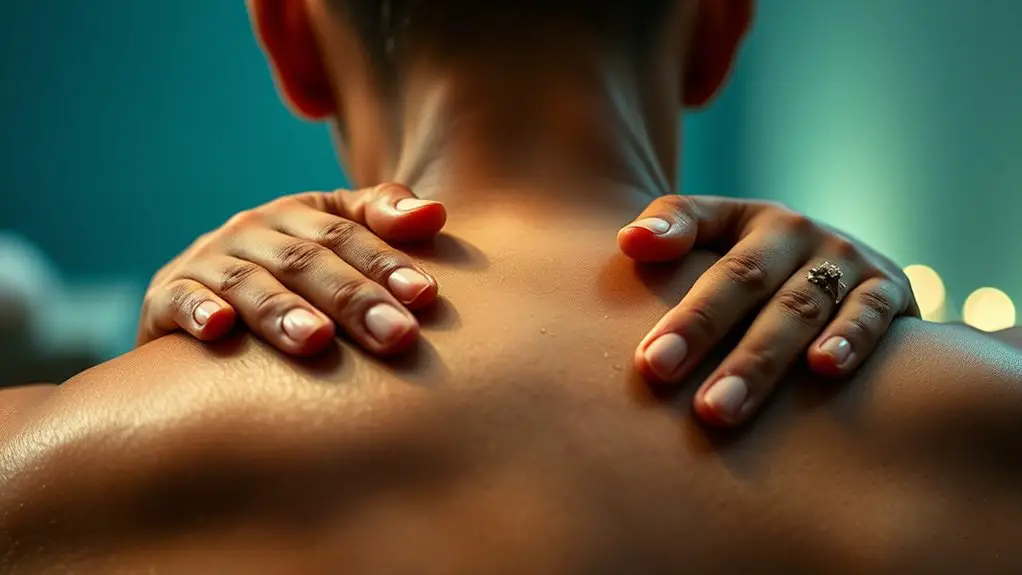Barefoot training improves foot strength by engaging deeper muscles and promoting natural movement patterns. By allowing your feet to work as they were designed, you activate dormant muscles, which helps build stronger arches and enhances balance. This training alters your foot strike toward the midfoot or forefoot, leading to better alignment and efficiency. As you strengthen your feet, you'll also lower your risk of injuries. There's so much more to discover about shifting safely and incorporating it into your routine.
Understanding Foot Anatomy and Function
The foot is a marvel of engineering, composed of 26 bones, numerous muscles, and intricate ligaments that work together to provide support and mobility. Understanding foot structure is essential for anyone seeking to embrace a more liberated lifestyle. Each part of your foot serves a unique purpose, from the arches absorbing shock to the toes stabilizing your balance.
You've got sensory receptors in your feet that connect you to the ground, helping you feel every texture and contour beneath you. This connection is crucial for maintaining your sense of freedom and agility, allowing you to navigate the world with confidence. When you tap into the natural design of your feet, you can enhance your strength, stability, and overall function. Embracing this knowledge can lead to an invigorating journey toward better foot health and greater independence in your movements. Additionally, core strength plays a vital role in supporting your overall stability and balance during movement.
The Science Behind Barefoot Training
When you consider barefoot training, it's fascinating to see how it influences your foot biomechanics. You'll notice that running without shoes engages your foot muscles more effectively, boosting their strength. Plus, it enhances your balance and proprioception, helping you move with greater agility and control.
Biomechanics of Barefoot Running
While many runners have embraced the trend of barefoot running, understanding the biomechanics behind it reveals how this approach can enhance foot strength and overall performance. When you run barefoot, your foot strike changes, often shifting to a midfoot or forefoot strike instead of the heel strike common with cushioned shoes. This shift encourages a more natural gait, promoting better alignment and reducing impact forces. Gait analysis shows that barefoot running activates muscles in your feet and lower legs that typically remain dormant in traditional running shoes. By engaging these muscles, you not only strengthen your feet but also improve your overall running efficiency. Embracing this freedom in movement can lead to a more connected and powerful running experience.
Impact on Foot Muscles
Barefoot training has a profound effect on the muscles within your feet, leading to improvements in strength and function. When you ditch the shoes, you enhance muscle engagement, activating deeper layers of your foot's musculature that traditional footwear often stifles. This increased engagement helps develop stronger arches and better overall support. You'll also notice a boost in foot flexibility, allowing your feet to adapt naturally to various surfaces. With every step, you encourage your muscles to work harmoniously, promoting balance and efficiency. As your feet become stronger and more flexible, you'll experience a newfound freedom in movement, breaking free from the constraints of conventional shoes. Embrace the journey to stronger feet and release your body's potential.
Balance and Proprioception Benefits
As you shift to barefoot training, you'll likely notice significant improvements in your balance and proprioception. Without the cushioning of traditional shoes, your feet engage more deeply with the ground, enhancing your proprioceptive awareness. This heightened sensitivity allows you to better detect shifts in your body's alignment and position, making activities feel more intuitive and freeing. Incorporating balance exercises into your routine will further reinforce these benefits. Simple movements, like standing on one leg or practicing yoga poses, challenge your stability and strengthen the tiny muscles in your feet and ankles. As you embrace this natural approach, you'll discover a newfound confidence in your movements, empowering you to move freely and fluidly in all aspects of life.
Benefits of Enhanced Foot Strength
Enhanced foot strength can markedly reduce your risk of injuries, allowing you to stay active longer. With stronger feet, you'll also notice improvements in your balance and stability, making everyday activities easier and safer. These benefits can transform how you move, both in sports and daily life. Additionally, strong, healthy joints play a crucial role in overall athletic performance and can be supported through targeted exercises.
Injury Prevention Techniques
Strengthening your feet can play an essential role in preventing injuries, especially for those who engage in regular physical activity. Enhanced foot strength boosts ankle stability and foot mobility, reducing the risk of strains and sprains. By focusing on these areas, you can enjoy more freedom in your movements.
| Technique | Benefits | Tips |
|---|---|---|
| Barefoot Training | Improves foot strength | Gradually increase exposure |
| Balance Exercises | Enhances ankle stability | Incorporate into routine |
| Stretching | Increases foot mobility | Focus on calves and arches |
| Strength Training | Builds overall support | Use bodyweight exercises |
Incorporating these techniques can help you maintain healthy, resilient feet, allowing you to move freely and confidently.
Improved Balance and Stability
When you invest time in improving foot strength through barefoot training, you'll notice a significant boost in your balance and stability. This newfound freedom allows you to navigate your environment with confidence. Here's how enhanced foot strength contributes to that:
- Better Foot Alignment: Stronger muscles help maintain proper foot alignment, reducing the risk of missteps.
- Enhanced Sensory Feedback: Barefoot training increases your foot's sensory awareness, allowing you to adapt quickly to uneven surfaces and obstacles.
- Core Engagement: Improved foot stability supports your core, creating a solid foundation for overall body balance.
With these benefits, you'll feel more grounded, agile, and ready to embrace life's adventures without the fear of losing your footing.
How Barefoot Training Reduces Injury Risk
Barefoot training can greatly lower your risk of injury by promoting a more natural gait and improving your foot's proprioception. When you train barefoot, you develop stronger muscles and better coordination, which helps tackle common injury mechanisms. These training adaptations empower your feet, allowing them to respond more effectively to varied surfaces. Staying hydrated during workouts is also crucial, as dehydration can impair your performance and increase the likelihood of injury.
| Benefit | Description | Impact on Injury Risk |
|---|---|---|
| Enhanced Proprioception | Improves awareness of foot placement | Reduces missteps and slips |
| Strengthened Muscles | Builds intrinsic foot strength | Prevents strains and sprains |
| Natural Gait | Encourages proper alignment | Lowers impact stress |
Improving Balance and Stability Through Barefoot Training
While you might not realize it, training without shoes can markedly enhance your balance and stability. When you connect your feet directly with the ground, you engage more muscles and improve your proprioception. Here are three ways barefoot training can boost your balance:
Training barefoot connects you to the ground, enhancing balance and stability by engaging more muscles and improving proprioception.
- Increased Sensory Feedback: Your feet have numerous nerve endings. Training barefoot heightens your awareness of your surroundings, helping you adjust quickly during balance exercises.
- Strengthening Small Muscles: Without shoes, you activate the small muscles in your feet and ankles. This added strength is essential for effective stability drills, allowing you to move confidently.
- Improved Posture and Alignment: Barefoot training encourages proper alignment. As your body learns to adapt, you'll find your overall balance improves, making you feel more grounded and free in your movements. Enhanced proprioception serves as a safeguard against missteps during these exercises.
Embrace barefoot training, and experience a new level of stability and freedom!
Transitioning to Barefoot Training Safely
As you start your journey into barefoot training, it's crucial to shift gradually to prevent injuries and allow your feet to adapt. Begin with short sessions on soft surfaces, like grass or sand, to ease into the experience. Your change strategies should focus on gradual exposure; start with just a few minutes each day, then slowly increase your time. Pay attention to how your feet feel—discomfort is normal, but pain isn't.
Consider alternating between barefoot and traditional footwear to help your feet build strength without overwhelming them. As you gain confidence and comfort, you can explore more challenging terrains. Remember, your body needs time to adjust, so listen to it. Rest days are important for recovery, allowing your feet to strengthen and adapt during this transition. Embrace this liberating journey to better foot strength while being mindful of your limits. By taking these steps, you'll enjoy the freedom of barefoot training without sacrificing safety.
Incorporating Barefoot Training Into Your Fitness Routine
After you've safely adjusted to barefoot training, it's time to weave it into your fitness routine. Embracing the freedom that comes with using barefoot shoes can transform how you move. Here are three ways to incorporate barefoot training into your daily workouts:
- Start with Warm-ups: Begin each session with a few minutes in your barefoot shoes, focusing on ankle mobility and foot strength exercises to activate your muscles.
- Mix into Training Programs: Integrate barefoot runs or drills into your existing training programs. Alternate between traditional workouts and barefoot sessions to build strength and resilience.
- Mindful Cool Downs: After your workout, spend time barefoot, focusing on balance and proprioception. This helps you connect with your feet and enhances recovery.
Frequently Asked Questions
Can Barefoot Training Help With Flat Feet or High Arches?
Yes, barefoot training can help with both flat feet and high arches. By allowing your feet to move naturally, you'll strengthen the muscles that support your arches and improve overall foot function. It's all about giving your feet the freedom to adapt and grow stronger. You might find that with consistent practice, your foot mechanics improve, leading to better balance and comfort. So, why not give it a try? Your feet could thank you!
How Long Does It Take to See Improvements in Foot Strength?
It typically takes about 4 to 6 weeks to notice improvements in foot strength when you embrace barefoot training. In fact, a strength assessment shows that many individuals report a 30% increase in foot muscle activation within this timeframe. Your progress timeline can vary based on factors like consistency and your current level of fitness. But stay committed, and you'll likely find the freedom and strength in your feet that you've been seeking.
Is Barefoot Training Suitable for All Age Groups?
Is barefoot training suitable for all age groups? Absolutely! It can benefit everyone, from children's development to senior fitness. For kids, it promotes natural foot growth and balance. For seniors, it encourages stability and strength, reducing the risk of falls. Just remember to ease into it, as each age group might need a different approach. You'll find that embracing this freedom in movement can enhance your overall well-being, no matter your age!
What Types of Footwear Should I Avoid During Training?
You wouldn't want to train in high heels, right? Unless you're auditioning for a circus act! When it comes to footwear during training, steer clear of those high-heeled monstrosities and overly supportive sneakers that feel like you're wearing a cloud. They might seem comfy, but they can hinder your progress. Embrace the freedom of minimal footwear instead, allowing your feet to connect with the ground and truly strengthen. Your feet will thank you!
Can Barefoot Training Be Beneficial for Runners With Previous Injuries?
Absolutely, barefoot training can be beneficial for runners with previous injuries. It promotes natural foot movement, which helps strengthen muscles that might've weakened during injury recovery. You'll find that as your feet adapt, your overall runner performance may improve, allowing for a more efficient stride. Plus, it gives you the freedom to reconnect with the ground, enhancing your balance and stability. Just remember to ease into it to avoid overdoing it initially!




